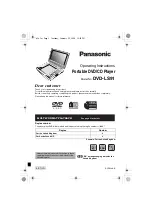
40
10. Commissioning
Only put the device into operation when you have become familiar with its features and these
operating instructions. Check again that all connections are correct. Do not put the product
into operation if it is damaged.
The amplifier for this equipment should always be the last to be turned on and the first to be turned
off. This will prevent any undesired noises (which can typically occur when switching off the CD
player) from damaging the amplifier or loudspeakers.
Make sure that the connected devices are not overloaded. Playback must never be distorted. If
distorted music signals can be heard although the volume on the amplifier is not set too high,
switch off the CD player immediately and check the connection. If the connection is correct,
please contact a specialist.
The device must only be operated by persons familiar with the operating instructions and
observing them. Keep the CD payer away from other persons or children.
Switching on the Devices
• Turn the volume control of the connected amplifier down completely.
• Push the power switch (32) to switch on the CD player.
• Then switch on the mixer, if connected, and then the amplifier.
Insert a CD
Do not insert any damaged CDs into the player. The high rotational speed may cause it to crack and
damage the device. Do not insert more than one CD.
Never interfere with the motor-driven movement of the CD disk charge opening (35).
• Place an audio CD in the CD charge slot (35) with the labelled side upwards. Hold the CD at the outer edge
and do not touch the CD on the inside. The CD is automatically drawn in and read.
• Then, the device automatically sets the CUE mark at the beginning of music in the first track on the CD and
goes into pause mode. You can now start playback.
The CD cannot be ejected during playback mode. This makes sure that the playback is not interrupted
unintentionally. Before pushing the OPEN/CLOSE button (16), stop playback.
Inserting USB Memory
The CD player can play music files in the MP3 and WAV formats. MP3 is a file format to compress music. Save
the MP3 files on a CD or USB drive and play these on the CD player without the need to connect this to your com-
puter. Different formats, bit rates, sampling frequencies, encoding procedures and playlists make it possible that
not all tracks are recognised at the USB input.
Due to the great variety of systems with USB interfaces, their different technical data (e.g. reading speed) and their
different functions, some of which are producer-specific, we cannot guarantee that all media will be recognized and
that all the operational functions are available on this device. Therefore, only use USB memory sticks.
















































